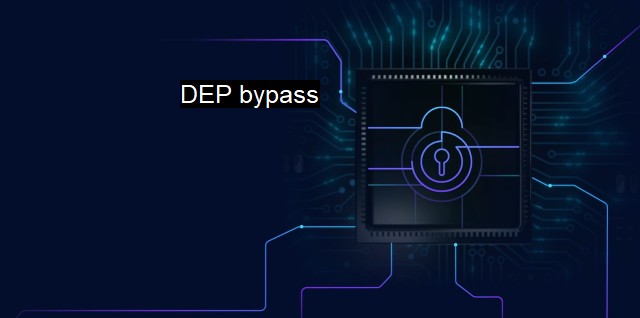What are DEP bypass?
Understanding DEP Bypass: A Cybersecurity Threat to Modern Operating Systems and How to Mitigate It
Data Execution Prevention (DEP) is a security feature that is included in most modern operating systems to prevent malicious software introduced to systems from executing code from a non-executable memory region. It will halt the process once the code is running from the memory region. This prevention mechanism increases the security of a system against exploits such as buffer overflows, by making it more difficult for an attacker to execute harmful code.However a DEP bypass refers to techniques and strategies used by malicious software and hackers to avert this security feature. An effective DEP bypass allows hackers to execute malicious code despite the computer system having DEP enabled, thereby exploiting vulnerabilities that would be normally guarded against by DEP.
To understand DEP bypass, some background knowledge is required. A computer's memory is divided up into different segments for more efficient management. Normally, there are separate sections for data and executable code. DEP functions by designating certain regions of a computer’s RAM as a non-executable area. If malicious software tries to run code in these particular areas, the command is halted. This separation and safety procedure is what makes DEP effective in safeguarding a system from common security threats.
Hackers have developed techniques to bypass DEP, hence the term "DEP bypass." The basic concept of a DEP bypass is quite rudimentary. If an area of memory which is meant for data storage and is normally non-executable can be tricked into executing a code, the DEP mechanism is bypassed. There are numerous methods to achieve this, but the most common technique involves tricking the system into thinking that the code is part of the actual programme which should run and is trusted.
For instance, Return Oriented Programming (ROP) is often utilised as a DEP bypass method. It involves using small pieces of legitimate code known as 'gadgets,' which end such that they affect the flow of control in the programme and return control to the attacker. The attacker can run their intended instructions by cleverly piecing together a sequence of these gadgets like assembling a jigsaw puzzle. ROP gets around DEP, as the code segments are from legitimate programs that are permitted to execute.
In light of these bypass techniques, antiviruses provide crucial countermeasures. The key role of antivirus software involves detecting, preventing, and removing malicious software from a computer system. Advanced antivirus software has started incorporating Behaviour Blocking technology which monitors the behaviours of all programs and flags off any suspicious activity. This detection method is highly useful in detecting non-signature exploits, scripts, or even to raise a red flag whenever they detect attempts to bypass DEP.
Antiviruses with DEP enforcement features take a further step by enforcing DEP on all processes and preventing any potential dep-bypass attack from being successful. innovative antivirus softwares employ prevention mechanisms which harden the system against ROP attacks by maintaining a close check on how legit codes are assembled by hackers to form a detrimental piece of code.
Cybersecurity firms frequently work to patch weak spots through system updates and novel antivirus software. Security solutions now work to outwit such DEP bypass techniques as part of their defence strategy, with constant monitoring for exploits that take advantage of DEP-disabled processes.
Despite the sophisticated security technique of Data Execution Prevention, perpetrators have found ways to bypass it. DEP bypass can render some computer systems vulnerable to malicious activities such as buffer overflows that DEP aims to prevent. Consequently, forearmed with knowledge about DEP bypass strategies, professional cybersecurity companies continuously develop defences in the form of antivirus software aimed at detecting and halting these bypass attempts, striving to stay one step ahead in the never-ending struggle between system defenders and cyber attackers.

DEP bypass FAQs
What is a dep bypass?
A dep bypass is a technique used in cybersecurity to disable or circumvent Data Execution Prevention (DEP) security to allow malicious code to execute. DEP is a security feature used by operating systems to prevent computer programs from executing code in non-executable memory areas.Why is dep bypass considered a threat to antivirus software?
Dep bypass is considered a threat to antivirus software because it allows malware to execute in areas that are usually protected. As a result, it can bypass the antivirus protection and allow malicious code to run undetected.How can I protect my computer from dep bypass attacks?
To protect your computer from dep bypass attacks, you can install the latest security updates and patches provided by your operating system vendor. You can also install a reliable antivirus software that can detect and block malicious code, including dep bypass attacks.Can dep bypass attacks be prevented entirely?
Unfortunately, dep bypass attacks cannot be prevented entirely as cybercriminals are constantly developing new ways of bypassing security defenses. However, by implementing best practices in computer security and using up-to-date antivirus software, you can minimize the risk of dep bypass attacks and protect your computer and personal data.| | A | | | B | | | C | | | D | | | E | | | F | | | G | | | H | | | I | | | J | | | K | | | L | | | M | |
| | N | | | O | | | P | | | Q | | | R | | | S | | | T | | | U | | | V | | | W | | | X | | | Y | | | Z | |
| | 1 | | | 2 | | | 3 | | | 4 | | | 7 | | | 8 | | |||||||